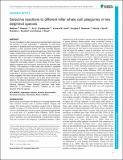Files in this item
Selective reactions to different killer whale call categories in two delphinid species
Item metadata
| dc.contributor.author | Bowers, Matthew T. | |
| dc.contributor.author | Friedlaender, Ari S. | |
| dc.contributor.author | Janik, Vincent M. | |
| dc.contributor.author | Nowacek, Douglas P. | |
| dc.contributor.author | Quick, Nicola | |
| dc.contributor.author | Southall, Brandon L. | |
| dc.contributor.author | Read, Andrew | |
| dc.date.accessioned | 2019-06-11T23:39:32Z | |
| dc.date.available | 2019-06-11T23:39:32Z | |
| dc.date.issued | 2018-06-12 | |
| dc.identifier | 251816223 | |
| dc.identifier | 94b7f6a3-09e7-4a09-988c-7e053b95362a | |
| dc.identifier | 85056114959 | |
| dc.identifier | 000438916100002 | |
| dc.identifier.citation | Bowers , M T , Friedlaender , A S , Janik , V M , Nowacek , D P , Quick , N , Southall , B L & Read , A 2018 , ' Selective reactions to different killer whale call categories in two delphinid species ' , Journal of Experimental Biology , vol. 221 . https://doi.org/10.1242/jeb.162479 | en |
| dc.identifier.issn | 0022-0949 | |
| dc.identifier.other | ORCID: /0000-0001-7894-0121/work/60427852 | |
| dc.identifier.uri | https://hdl.handle.net/10023/17874 | |
| dc.description | This research was supported by award RC-2154 from the Strategic Environmental Research and Development Program and funding from the Naval Facilities Engineering Command Atlantic and National Oceanic and Atmospheric Administration Fisheries, Southeast Region. | en |
| dc.description.abstract | The risk of predation is often invoked as an important factor influencing the evolution of social organization in cetaceans, but little direct information is available about how these aquatic mammals respond to predators or other perceived threats. We used controlled playback experiments to examine the behavioral responses of short-finned pilot whales (Globicephala macrorhynchus) off Cape Hatteras, NC, USA, and Risso's dolphins (Grampus griseus) off the coast of Southern California, USA, to the calls of a potential predator, mammal-eating killer whales. We transmitted calls of mammal-eating killer whales, conspecifics and baleen whales to 10 pilot whales and four Risso's dolphins equipped with multi-sensor archival acoustic recording tags (DTAGs). Only playbacks of killer whale calls resulted in significant changes in tagged animal heading. The strong responses observed in both species occurred only following exposure to a subset of killer whale calls, all of which contained multiple non-linear properties. This finding suggests that these structural features of killer whale calls convey information about predatory risk to pilot whales and Risso's dolphins. The observed responses differed between the two species; pilot whales approached the sound source while Risso's dolphins fled following playbacks. These divergent responses likely reflect differences in anti-predator response mediated by the social structure of the two species. | |
| dc.format.extent | 12 | |
| dc.format.extent | 1637779 | |
| dc.language.iso | eng | |
| dc.relation.ispartof | Journal of Experimental Biology | en |
| dc.subject | Antipredator behavior | en |
| dc.subject | Acoustic discrimination | en |
| dc.subject | Non-linear acousitcs | en |
| dc.subject | Pilot whales | en |
| dc.subject | Risso's dolphins | en |
| dc.subject | QH301 Biology | en |
| dc.subject | NDAS | en |
| dc.subject.lcc | QH301 | en |
| dc.title | Selective reactions to different killer whale call categories in two delphinid species | en |
| dc.type | Journal article | en |
| dc.contributor.institution | University of St Andrews. School of Biology | en |
| dc.contributor.institution | University of St Andrews. Sea Mammal Research Unit | en |
| dc.contributor.institution | University of St Andrews. Marine Alliance for Science & Technology Scotland | en |
| dc.contributor.institution | University of St Andrews. Scottish Oceans Institute | en |
| dc.contributor.institution | University of St Andrews. Institute of Behavioural and Neural Sciences | en |
| dc.contributor.institution | University of St Andrews. Centre for Social Learning & Cognitive Evolution | en |
| dc.contributor.institution | University of St Andrews. Bioacoustics group | en |
| dc.identifier.doi | https://doi.org/10.1242/jeb.162479 | |
| dc.description.status | Peer reviewed | en |
| dc.date.embargoedUntil | 2019-06-12 |
This item appears in the following Collection(s)
Items in the St Andrews Research Repository are protected by copyright, with all rights reserved, unless otherwise indicated.

